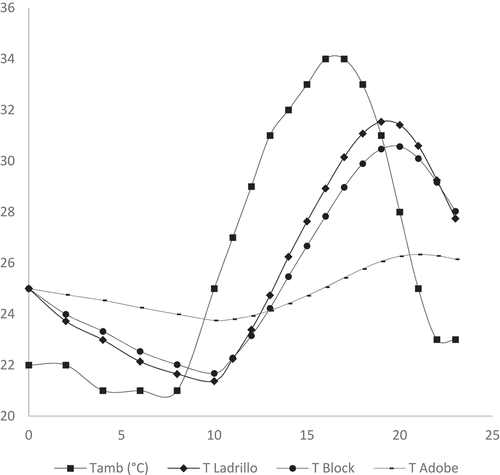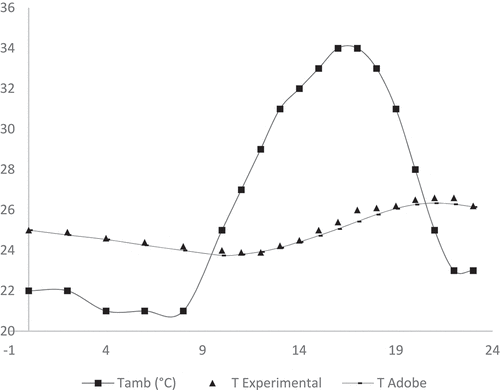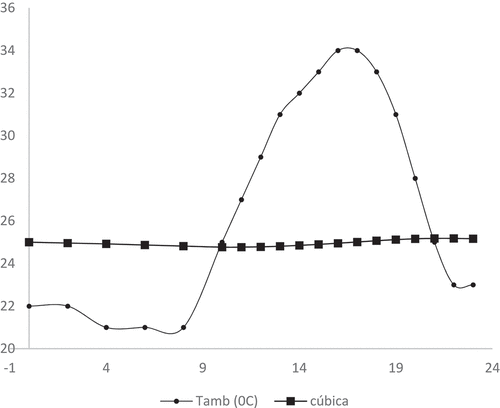 ?Mathematical formulae have been encoded as MathML and are displayed in this HTML version using MathJax in order to improve their display. Uncheck the box to turn MathJax off. This feature requires Javascript. Click on a formula to zoom.
?Mathematical formulae have been encoded as MathML and are displayed in this HTML version using MathJax in order to improve their display. Uncheck the box to turn MathJax off. This feature requires Javascript. Click on a formula to zoom.Abstract
In Mexico, there are efforts to recover earth-based construction systems, mainly those that improve the comfort characteristics consisting of a thermal sensation different from that of the environment. One of the questions derives from the reason why, at high ambient temperatures, earth houses tend to have a much lower temperature inside while, at very low temperatures, indoor temperatures are higher. This paper analyzes a type of housing present in Tamaulipas, Mexico, characterized by adobe walls and palm roofs. From a specific solution of the transport equations considering the heat capacity of the material and the coefficient of thermal conductivity, it is shown that the heat transfer of a homogeneous material in housing is dominated by these two properties, which justifies the present architectural design and the paradigm of a better comfort of earthen dwellings concerning industrialized materials such as the concrete block, we also show the energy efficiency according to NOM-020-ENER-2011.
1. Introduction
Mexico has a national problem in the field of housing because more than 40% of the vulnerable population does not have a home. In several cases, the vulnerable population is in communities that have availability of natural materials and land, there are cases of construction with adobe or mud, which are currently promoted as a feasible strategy for the development of housing with a lower cost (Morales-Cristóbal et al., Citation2020). Several authors have shown that resistant mixtures for walls can be obtained under certain geometric characteristics
On the other hand, several studies have been carried out to evaluate the thermal behavior of adobe constructions (Parra-Saldivar & Batty, Citation2006), demonstrating the sustainable relevance (Acosta et al., Citation2010) and that allows thermal comfort also in cold areas (Yuan et al., Citation2022) or arid-hot (Bassoud et al., Citation2021). It is important to note that most studies use a broad set of variables to perform the analysis and have considered many components within the measurements (Kaboré et al., Citation2021), as well as the environmental conditions, present including seeing speeds and humidity, among others. For studies on the improvement of thermal sensation, the components and elements that can store heat have been modified for cases where a temperature must remain (Holguino Huarza et al., Citation2018).
These results have led to improved mechanical properties of earth elements, mainly adobe, by adding fibers and analyzing durability (Babé et al., Citation2021).
The possibility of using construction systems that use mixtures of earth and various strategies is being revalued. In some countries, they are inspired by traditional architecture from inherited experiences (Lidón de Miguel et al., Citation2021) that is valid for different areas of the world including those recognized as seismic (Pennacchio et al., Citation2022), in which the mixture of earth elements with organic reinforcements and biomass such as fibers and wood is also considered, which also includes Latin American countries (Baquedano et al., Citation2021). The vernacular aspect is usually accompanied by the use of bioavailable materials such as palm and bamboo that are generally considered sustainable for the various cases (Cortes & Aguilar, Citation2002; Lara et al., Citation2014)
Traditional and vernacular architecture, in addition to earthen architecture, is commonly found throughout Mexico (Loreto, Citation2012; Serrano-Barquín et al., Citation2009) showing different strategies even with the same construction systems based on earth, palm and wood, double height walls, gabled or pitched roof, among others.
There is an area in the north of Mexico that has various uses of materials, which can be retaken to obtain accessible housing (Morales-Cristóbal et al., Citation2020) highlighting the area recognized as the Huastec that addresses the States of Hidalgo, Tamaulipas, San Luis Potosí and Veracruz, however, although there is talk of an area it occupies a very large geographical extension, this implies a set of different contextual features, including variable heights in terrain, soil composition, availability of materials (such as bamboo, wood, palm …), temperature and humidity, plus various aspects such as the proximity to water tables and wetlands which add various variables resulting in a particular form of architectural design for each area of the same region and that must be considered.
The municipality of San Carlos is in the Sierra of the same name. The climate is semi-arid and extreme with temperatures ranging between 45°C and 6°C; winter frosts are common in the elevated parts. The center is located on an internal plain at 480 meters above sea level. The houses were initially built of adobe and stone, a common material in the region, characterized by adobe walls and the absence of windows.
2. Method
A survey of adobe houses was carried out, finding that 80% of the land dwellings located had the same characteristics, placing the measurements of the dwellings. The main material in walls was characterized. For the representative material, the heat capacity and thermal conductivity were determined from a diffusivity measuring device model: KD2 Pro Thermal Properties Analyzer from Decagon Devices, Inc.
For the analysis, the existing materials in the area were used. The average height of the houses was determined at 3 meters, locating the absence of windows or windows of dimensions made up of a single square of 0. 5 m side.
The walls are on average 25–30 cm thick in all cases. shows the representative images of the study area. For the case of Tampico Alto, Veracruz, properties are similar but with a 12 cm thick wall.
The adobe used in the area corresponds to a mixture of clay soil that is available on the benches around the central municipality. The grass content is from 5 to 15% by weight. These elements are common in the area, and these were taken and sent to the laboratory to obtain their thermal properties. Concerning clay soil, the material was collected to identify global properties, including liquid and plastic boundaries following NMX-C-493-ONNCCE-Citation2018.
From the energy transport equations, an analytical solution was obtained from the basic principles of transport phenomena. To obtain the model, a transport was considered exclusively by conduction and that of the air present in a room is by convection presenting a partial differential equation:
which includes the temperature in the wall (), the time (
), the distance measured taking as a reference the outer side of the wall (
) and
that are the heat capacity and the coefficient of thermal conductivity of the wall exposed to the sun.
The temporal behavior of the air temperature in the room is given from the volume
and the area
in the room (sum of the areas of the walls and the ceiling),
is the thickness of the wall, while and are the heat capacity and the coefficient of heat transport by natural convection of the air:
The solution was obtained according to Suárez-Domínguez et al. (2022), resulting in (Chavez-Vega et al., Citation2022):
Finally, the calculation of energy efficiency was carried out in accordance with NOM-020-ENER-2011, based on the calculation tool generated with support and technical advice from the Danish Energy Agency, by the Ministry of Energy (SENER) and the National Commission for the Efficient Use of Energy (CONUEE, Citation2022). For this the data of the building are entered entering only the data of the thermal envelope of the projected building and that in this case corresponded to the averages shown in , with a façade facing east and a base floor of 5 m of façade and 4 m of background. The (driving gain) and the (envelope area)
are calculated.
Whereas
is the Radiation Gain,
is the Heat Gain.
3. Results and discussion
The earth material used in the area to make adobe was tested at the laboratory level, obtaining the following data:
Plastic Limit of 17.89% and Liquid Limit of 32.09% with a linear contraction of 1.8%.
51.2% by weight of the clay soil passes through mesh # 40 and 41.8 passes through mesh #200.
shows the results obtained for the measurement of the three materials present in the community of San Carlos.
Table 1. Results obtained for the measured variables
shows the results obtained for indoor temperatures throughout the 24 hours of the day, for a thickness of 12 cm in all cases. The highest curve corresponds to the ambient temperature for a common day in the month of May. Due to the geographical location within the Sierra de San Carlos, the highest temperature is 34°C but it can decrease to about 21°C. In the case of industrial materials such as block or brick, there are differences of 3.2 to 4.8°C while for adobe there is a temperature difference close to 9°C. It is important to consider what laboratory level this material was produced at so that it was geometrically analogous to brick or block, but that is usually higher for the case of adobe.
Figure 2. Temperature curves. Outside temperature (Tamb °C), interior temperature for brick, block, and adobe.

shows the case in which the calculation is made and the interior temperature is obtained for the case of a wall made of adobe 12 cm thick and that is maintained with an external temperature according to the ambient temperature. From the experimental results, experimental temperatures were found to have differences of less than 1°C when contrasted with the theoretical results.
Figure 3. Predicted and experimental results for the case of walls of 12 cm thick adobe. The steep curve corresponds to the outside temperatures.

Finally, shows the results in housing built with adobe walls 30 cm thick and corresponding to the traditional thickness for vernacular housing walls in the municipality of San Carlos.
Regarding the calculation of energy efficiency, in accordance with NOM-020-ENER-2011, results are shown in .
Table 2. Energy efficiency
shows results about the industrial reference building where showing a 51% and 49% less energy for and adobe building from San Carlos Tamaulipas and a building from Tampico Alto, Veracruz.
This behavior is interesting because it represents the possibility of microclimates. Hermawan, H. has presented various studies on the impact of materials and spaces on the interior temperature of buildings as well as the ability of an adaptive design in certain areas to improve comfort (Hermawan & Švajlenka, Citation2022, Citation2021). The application of the exposed model makes it possible to foresee that the use of the material in earth buildings in Tamaulipas, has thermal properties that would help to improve the comfort of the dwelling, thus reducing energy consumption.
4. Conclusions
In this brief report, from the analysis of the material and the characteristics of housing, it was found that from the heat capacity and thermal conductivity the interior temperature of the walls can be reproduced, regardless of the humidity that exists in the place. Also in case of reducing the flow of hot air, an interior temperature is maintained without fluctuations for the conditions studied, which can be correlated to what is visualized in homes, where there is a reduced number of windows on walls.
The findings indicate that the temperatures that will be in a space for the use case of certain materials can be estimated with an error of less than 5%. In the case of temperatures for walls with industrialized materials, the model also made a reproduction of the temperature value with differences of less than 1.5°C.
According to the Standard NOM-020-ENER-2011, the energy efficiency of a building base plant is 51% for the adobe material used.
Aknowledgements
EAS and RRGV thank the PRONACES project 315372 for the support received and information captured for land, and the CONACYT project 316443 for the facilities in the maintenance of laboratory equipment used in this research. FRC and MECV thank the UAT-INV-183 project.
Disclosure statement
No potential conflict of interest was reported by the author(s).
Additional information
Funding
References
- Acosta, J. D., Diaz, A. G., Zarazua, G. M., & Garcia, E. (2010). Adobe as a sustainable material: A thermal performance. Journal of Applied Sciences, 10(19), 2211–8. https://doi.org/10.3923/jas.2010.2211.2216
- Babé, C., Kidmo, D. K., Tom, A., Mvondo, R. R. N., Kola, B., & Djongyang, N. (2021). Effect of neem (Azadirachta Indica) fibers on mechanical, thermal and durability properties of adobe bricks. Energy Reports, 7, 686–698. https://doi.org/10.1016/j.egyr.2021.07.085
- Baquedano, P., Eudave, R. R., Miranda, F. N., Graus, S., & Ferreira, T. M. (2021). Traditional earth construction in Latin America: A review on the construction systems and reinforcement strategies. Masonry Construction in Active Seismic Regions, 99–121. https://doi.org/10.1016/B978-0-12-821087-1.00011-9
- Bassoud, A., Khelafi, H., Mokhtari, A. M., & Bada, A. (2021). Evaluation of summer thermal comfort in arid desert areas. case study: Old adobe building in Adrar (South of Algeria). Building and Environment, 205, 108140. https://doi.org/10.1016/j.buildenv.2021.108140
- Chavez-Vega, F., Calvillo-Villicaña, M. E., Suarez-Dominguez, E. J., Arvizu-Sanchez, E., Estrada-Castro, K. E., Perez-Sanchez, J. F., Izquierdo-Kulich, E. F., & Kunelbayev, M., Reviewing editor. (2022). About the comfort of house-buildings with earth walls in San Carlos, tamaulipas. Cogent Engineering, 9(1). https://doi.org/10.1080/23311916.2022.2096524
- CONUEE (2022). https://www.google.com/url?sa=t&rct=j&q=&esrc=s&source=web&cd=&ved=2ahUKEwjN5eeJtO34AhX1kGoFHUOSBGYQFnoECBAQAw&url=https%3A%2F%2Fwww.conuee.gob.mx%2Ftransparencia%2FGuiaHerramientaCalculoNOM_020_V1.00.pdf&usg=AOvVaw0k1bxdqmjEm_bCbM3pUIjr
- Cortes, G. R., & Aguilar, R. I. (2002). Use of bamboo in the huts of rural Mexico. In Bamboo for sustainable development (pp. 673–678). Brill. https://doi.org/10.1163/9789004473911_062
- Hermawan, H., & Švajlenka, J. (2021). The connection between architectural elements and adaptive thermal comfort of tropical vernacular houses in mountain and beach locations. Energies, 14(21), 7427. https://doi.org/10.3390/en14217427
- Hermawan, H., & Švajlenka, J. (2022). Building envelope and the outdoor microclimate variable of vernacular houses: analysis on the environmental elements in tropical coastal and mountain areas of Indonesia. Sustainability, 14(3), 1818. https://doi.org/10.3390/su14031818
- Holguino Huarza, A., Olivera Marocho, L., & Escobar Copa, K. U. (2018). Thermal comfort in an adobe room with heat storage system in the Andes of Peru. Journal of High Andean Research, 20(3), 289–300.
- Kaboré, B., Ouedraogo, G. W. P., Imbga, B. K., Zoma, V., Kam, S., & Bathiebo, D. J. (2021). Numerical study of the thermal environment in a habitat: Materials analysis. Journal of Materials and Environmental Science, 12(12), 1538–1549.
- Lara, R. L., Robledo, M. A., Hernández, H. R., & Martínez, J. F. (2014). La sostenibilidad de la vivienda tradicional: Una revisión del estado de la cuestión en el mundo. Revista de arquitectura, 16(1), 126–133. https://doi.org/10.14718/RevArq.2014.16.14
- Lidón de Miguel, M., Vegas, F., Mileto, C., & García-Soriano, L. (2021). Return to the native earth: Historical analysis of foreign influences on traditional architecture in Burkina Faso. Sustainability, 13(2), 757. https://doi.org/10.3390/su13020757
- Loreto, J. (2012). Arquitectura de tierra en Sonora. Estudios sobre arquitectura y urbanismo del desierto, 4(4), 12.
- Markman, S. D. (1990). La arquitectura popular o vernácula como reflejo de las condiciones económicas de Chiapas colonial. Mesoamérica, 11(20), 267–274.
- Morales-Cristóbal, R., Sánchez-Medrano, M. T., Arista-González, G. J., & Suárez-Domínguez, E. J. (2020). Comparison of housing construction systems in the huasteca zone: Vernacular, industrialized and hybrid. Study cases. Case Studies in Construction Materials, 13, e00359. https://doi.org/10.1016/j.cscm.2020.e00359
- NMX-C-493-ONNCCE-. (2018). Construction industry-geotechnics-soil consistency limits-test method. Normal Mexican Official.
- Parra-Saldivar, M. L., & Batty, W. (2006). Thermal behaviour of adobe constructions. Building and Environment, 41(12), 1892–1904.
- Pennacchio, R., De Filippi, F., Bosetti, M., Aoki, T., & Wangmo, P. (2022). Influence of traditional building practices in seismic vulnerability of Bhutanese vernacular rammed earth architecture. International Journal of Architectural Heritage, 16(3), 374–393. https://doi.org/10.1080/15583058.2020.1785044
- Serrano-Barquín, H., Hernández-Moreno, S., & Mendiola-Germán, I. (2009). Revalorización de la arquitectura popular en la conservación del patrimonio mexiquense. Legado de Arquitectura y Diseño, 4(6), 11–18.
- Yuan, J., Cong, Y., Yao, S., Dai, C., & Li, Y. (2022). Research on the thermal comfort of the elderly in rural areas of cold climate, China. Advances in Building Energy Research, 1–31. https://doi.org/10.1080/17512549.2022.2067229


